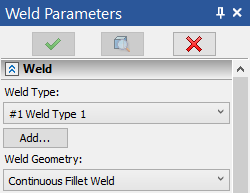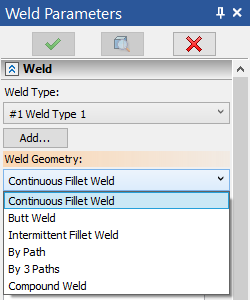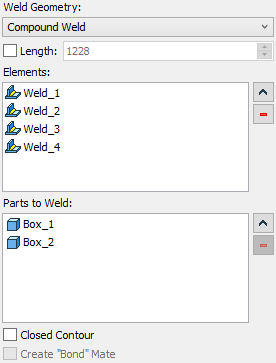Create 3D Weld > Compound |
  
|
To create a compound 3D weld, you need to perform following actions, upon calling the ![]() 3D Weld command:
3D Weld command:
3.Select source elements and define geometrical parameters of weld;
4.Define length of weld (optional step);
5.Define basic parameters and side processing (optional step);
6.Confirm the weld creation (![]() or <Ctrl>+<Enter>).
or <Ctrl>+<Enter>).
When creating a weld, you may also use dynamic preview and preview of operation result.
The type of weld can be selected in the Weld Type drop-down list located at the top of the Weld section of the command's parameters window. The list contains all types of welds created in the current T-FLEX CAD document.

If the required weld type is not yet created, you can use the Add button. Clicking this button starts the command of the new weld type creation. When the type is created, the system returns to the weld creation command. The created weld type will be automatically selected.
How to create a new weld type is described in the Weld Type section.
In addition to the user-created weld types, the list also contains the Non-Standard option, which allows creation of a weld not belonging to any type.
When using the Non-Standard weld type option, the creation of a compound weld is not possible.
Select a geometry type using the Weld Geometry drop-down list located in the upper part of the Weld section of the command's parameters window.

Following geometry types are available:
•Butt
The Compound Weld option is not available in the list, if the Weld Type field specifies Non-Standard.
Source Elements and Geometrical Parameters

Upon selecting a Compound Weld Geometry type, following options become available in the automenu:
|
<C> |
Select Weld Elements |
This option gets activated automatically on appearance. Use it for selecting existing elements of 3D model, which will be considered as representing the geometry of the resulting weld. Operations, edges, 3D profiles, 3D paths and other 3D welds can be selected for this purpose. You can use the filter toolbar for managing the type of elements available for selection. Selected elements are displayed in the Elements list in the Weld section of the command's parameters window. In order to exclude an element from selection, click it row in the list with ![]() and then use the
and then use the ![]() Delete Element from the List button located to the right.
Delete Element from the List button located to the right.
|
<D> |
Select Weld Parts |
This option allows to additionally specify bodies representing the parts to be welded. Selected elements are displayed in the Parts to Weld list in the Weld section of the command's parameters window. In order to exclude an element from selection, click it row in the list with ![]() and then use the
and then use the ![]() Delete Element from the List button located to the right. The selection of parts is not mandatory - a weld may be created without it.
Delete Element from the List button located to the right. The selection of parts is not mandatory - a weld may be created without it.
The method of calculating the weld length is determined by the state of the Length checkbox located below the list of weld geometry types. When the checkbox is disabled, the weld length is calculated by the system automatically. When the checkbox is enabled, the length value is defined by the user in the input box next to the flag.
Basic Parameters and Side Processing
When using a user-created weld type, the parameters window contains the Basic Parameters, Face Side Processing and Back Side Processing sections. the content of these sections is the same as described for 2D welds. When using the Non-Standard weld type option, these sections are not available.
Parameters set in Basic Parameters, Face Side Processing and Back Side Processing sections are used for creation of weld symbols.
See Also: